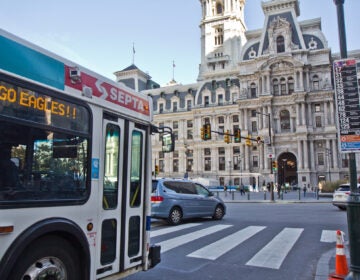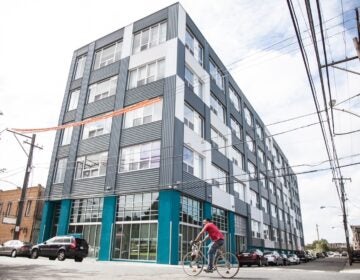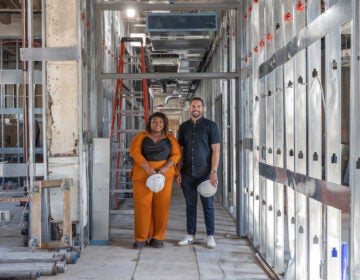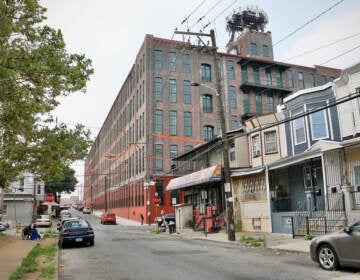‘What we need is leadership’: Kensington councilmembers say mayor is failing community
Councilmember María Quiñones-Sánchez and other community leaders say Mayor Jim Kenney must invest in housing and cleanup in the opioid hotspot.
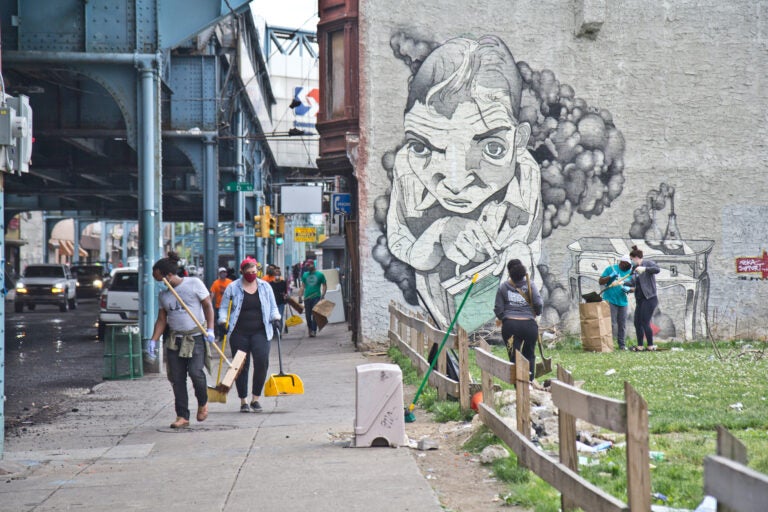
Volunteers with New Kensington CDC clean up in Kensington on June 1, 2020. (Kimberly Paynter/WHYY)
Michael DonPailin lives and works in Kensington.
As part of his job with the area nonprofit Impact Services, he supervises street cleaning in the neighborhood.
“This is the bottom of the barrel — there’s no part of the city that looks as bad as Kensington,” he said.
The people who live in Upper Kensington, the area around Kensington and Allegheny, are among the poorest in the city. The neighborhood has the highest drug overdose rate in Philadelphia, the highest rate of unemployment, and its residents collectively report more health problems than people in any other part of the city, according to a 2019 city report on health in Philadelphia neighborhoods. According to community leaders, the coronavirus pandemic, the resulting economic crisis, and the destruction seen in the neighborhood in the recent weeks, have only made the situation worse.
On Tuesday morning, community leaders, city and state representatives gathered outside of Kensington’s Esperanza Health Clinic under the elevated train to ask Mayor Jim Kenney’s administration to clean up the streets, invest in better health and safety conditions for the area, and remove drug users’ encampments.
“We have a plan, we have capacity, we have civic leaders willing to work together, we have a police department that cares,” Councilmember María Quiñones-Sánchez said, visibly frustrated. “What we need is leadership.”
Quiñones-Sánchez presented what she called the fifth iteration of a plan — called “2020 Restorative Investment Plan for Kensington Residents” — that asks for neighborhood improvements, such as better lighting and cleaning of streets and alleys, as well as funding for social services, home repairs, rental and utility bill support, and access to affordable housing. It also asks for the administration to provide better access to drug treatment and a strategy that ensures the safety and quality of life of those living in the area.
The move comes one week after she introduced a resolution to authorize hearings to assess the city’s efforts to prevent abuse and addiction.
“We have watched this administration, when it wants to, clear out the airport encampment, clear out the encampments around the Convention Center, and it is now negotiating the Parkway encampment. … When are you going to help the homeless in Kensington so we can restore the quality of life to the residents who live here?” she said.
Litter, needles and uncollected trash bags from the week filled the streets surrounding Quiñones-Sánchez as she spoke. Volunteers, social workers and residents cleaned up alleys.
DonPailin said he and others rarely see city trash trucks in the area, especially since COVID. He and other residents say drug dealers and users sitting on sidewalks and making impromptu encampments are a far more common sight.
“It’s getting worse because there’s more and more people coming and we can’t control where they camp,” he said. “They’re getting even bolder. They’re shooting up in ears and in necks, and you know, we’ve got kids riding past.”
The Kenney administration says it has invested tens of millions of dollars responding to the opioid crisis and improving the quality of life in Kensington. Through the Philadelphia Resilience Project, created in 2018, the administration has closed encampments, increased access to shelter and treatment, and improved safety and security for neighbors. Mike Dunn, a spokesman for the Kenney administration, said officials are now assessing priorities for the area after budget cuts forced by the COVID-19 crisis and seeking outside funding to support efforts.
“But despite those financial challenges, the City’s efforts to improve Kensington continue without letup,” Dunn said. “For example, we are convening weekly, interdisciplinary responses in the neighborhood — bringing multiple service providers to individuals and literally meeting them where they are, and engaging them around housing and treatment resources.
Dunn said that city workers will, this week, resume cleaning and providing other services at “multiple hot spots in the Kensington area, including the tunnels and Somerset.”
But those efforts are not enough to stop the daily indignities and health hazards experienced by residents, community leaders say.
“The neighborhood is sick and tired of having to deal with this — walking out their door whether they tread on needles, tread on human feces, have to live with the smell and the stench of what goes on because we’re allowing it to happen,” Councilmember Mark Squilla.
At the press conference, community leaders described the city’s strategy as “doing nothing.”
“When has doing nothing worked for your kids, for your household? In your lives, if you’ve dealt with substance abuse, when was doing nothing ever worked for you?,” said Casey O’Donnell, executive director of Impact Services. “It hasn’t. You can’t wait it out.”
O’Donnell said the current options for treatment don’t meet the community’s needs, resulting in people remaining unhoused and on the streets.
“People that are injecting fentanyl five times a day are not coming off the streets because existing treatment modalities do not work for this population,” he said.

Subscribe to PlanPhilly
Safe injection sites? Not in Kensington, leaders say
Last week, a judge put an indefinite hold on Philadelphia’s plans for a supervised injection site. But according to Billy Penn, Safehouse leaders said if and when it opens, they’re looking at Kensington for its first location.
“Well, that’s not going to happen,” said Quiñones-Sánchez after the press conference. “Ronda [Safehouse VP Ronda Goldfein] and Safehouse need to shut up and listen, they need to shut up and they need to listen. Kensington is not going to be another dumping ground or another pilot. We’re not guinea pigs anymore.”
Hector Ayala, president and CEO of Hispanic Community Counseling Services, who has been providing behavioral and mental health service in the neighborhood for 20 years, said a supervised injection site would serve as a bandage to the problem without providing a long-term solution.
“Yes, it saves life, but we are not addressing why these individuals are here, why these individuals are using, why these individuals feel alone, why these individuals they feel left out of the community,” Ayala said.
The real way of solving the problem, he said, is reconnecting users with their families and their communities.
Ayala said the city and community organizations already have a system in place with people constantly approaching users and creating access for treatment to them. What needs to happen next, he said, is stopping people from injecting themselves in the streets. People who decline treatment or help should be tracked through outreach efforts, he said.
These individuals should “understand that the status quo is not acceptable anymore,” he said.
Ayala said although incarcerating users is not the way of solving the problem either, sometimes, some people, need that “hard approach.”
“When that person makes that decision, that person needs to face the consequences of not getting the help and not engaging in safer behaviors,” he said.
DonPailin said the situation revealed racism and inequities. “It’s all minority neighborhoods so we don’t get the same type of treatment as Roxborough would get,” he said. “[Those areas] don’t look like this.”
Cara Tratner, who lives in the neighborhood and is an activist with Philadelphia Community Bail Fund said it’s not that people don’t want help, it’s that there’s no resources available.
“There’s no housing available. There’s no resources available. People can’t get a source of income. How are people going to survive on the street with no source of income and no housing?” she said.
One Kensington volunteer, Al Perez, who cleans needles and provides Narcan, an overdose-reversing drug, stood throughout the press conference with a sign declaring, “Homelessness is not a crime.”
Perez, who stopped using opioids four years ago, said the city should provide more help and treatment to users. If they refuse treatment, they have to move on, he said.
“Well, they got a choice,” Perez said. “You can’t really do nothing, but they can’t stay in here.”
WHYY is your source for fact-based, in-depth journalism and information. As a nonprofit organization, we rely on financial support from readers like you. Please give today.



